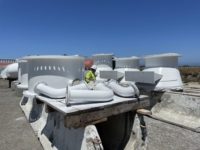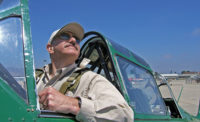Shortly after a 6.9-magnitude earthquake hit San Francisco in 1989, Clark Manus, CEO of Heller Manus Architects, assembled a group of local architects to help redesign and rebuild the devastated areas. The team, comprised of American Institute of Architects San Francisco members, produced a report that evaluated the benefits of removing the damaged Embarcadero Freeway.
After the report was presented to officials, San Francisco Mayor Art Agnos sought further urban design and architectural advice from Manus.
“I was convinced that the freeway, which was really a barrier to the waterfront, should be removed, and ultimately the mayor took my advice,” Manus says. “Through a very politically charged dialogue on the removal, my dialogue with [the mayor] aided him in being a forward-looking leader and [in seeing] the overwhelming benefits to San Francisco.”
Thirty years later, most experts agree that getting rid of the elevated freeway and reconnecting the eastern waterfront to the city was the right move.
Since that time, Manus has continued to put his architectural imprint on the Bay Area, where he has designed nearly 50 major projects. Manus, this year’s recipient of ENR’s Northern California Legacy Award, has broad experience in new and reconstruction work for mixed-use, civic, rehabilitation and adaptive reuse, performance facilities, academic and urban design and master-planning projects.
“While I love the early process of identifying and creating solutions to problems, watching a building or space take shape and learning over time how people interact with the building and the physical [components] is the most exciting,” says Manus.
He earned a bachelor’s degree in environmental design and psychology from the University of Buffalo and a master’s degree in architecture from the University of Pennsylvania. He says his undergraduate education helped him understand how the social sciences intersect with design.
“It motivated me to become an architect and equipped me with the health, safety and welfare skills that can improve people’s lives through architecture and the built environment,” he says.
After college, Manus worked for three years at a Philadelphia architecture firm before moving to California, where he met Jeff Heller, and together they founded Heller Manus in 1984.
Some of Manus’ most notable Bay Area projects include the San Francisco State Campus master plan, with its high-rise student housing; Hotel Vitale in San Francisco, a 200-room boutique hotel that was carefully integrated with public transit; the 500,000-sq-ft renovation and restoration of San Francisco’s historic City Hall; and The Infinity, a 655-unit residential village in the city’s Rincon Hill neighborhood.
The Infinity was the first major high-rise residential project built in the area and features the first performance-based design (PBD) used on a structural system in a seismic zone in California. Manus says the use of PBD on The Infinity tower helped increase density and created a new San Francisco neighborhood in Rincon Hill and Transbay. Designers also found ways to work around old planning height limits and building codes that limited residential towers in the city.
Manus says he suggested using PBD on The Infinity to his longtime structural-engineering collaborator Ron Klemencic of Seattle-based MKA. “Collaboratively, we were able to encourage our client on The Infinity to pioneer this system, and every high-rise residential tower in San Francisco since has utilized this advanced system,” he says.
When not designing large, complex projects, Manus finds time to give back to the architectural profession. For the past three years he has served as a planning commissioner for the city of Oakland and served as national AIA president from 2010 to 2011. At AIA he led initiatives on healthy, sustainable and resilient communities, including disaster planning and energy efficiency. He also led the inaugural AIA foreign-trade missions to India with the U.S. Dept. of Commerce.
“Clark brought an informed interest in national and international events to the AIA,” says Robert Ivy, AIA executive vice president and CEO. “His personal values found expression in plans and projects such as engaging our foundation in planning work to aid Haiti in the face of devastating loss following the earthquake there, or his time and commitment to related organizations such as Architecture for Humanity.”
“Being AIA president was a life-changing experience,” says Manus, who was also named to the AIA College of Fellows. “I was involved on an international level in helping to facilitate AIA membership in places like China, and I was a steward and a change agent to try and continue to make the AIA relevant to its members on services and advocacy issues that are important to them and society.”










Post a comment to this article
Report Abusive Comment